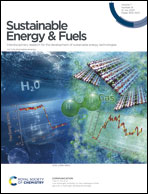Visible-light driven photocatalytic CO2 reduction promoted by organic photosensitizers and a Mn(i) catalyst†
Abstract
Photocatalytic systems for CO2 reduction can greatly benefit from the development of fully organic photoredox sensitizers, so as to move away from the use of rare elements. In this study, a series of organic molecules, displaying thermally activated delayed fluorescence (TADF) containing diphenylamine (4DPAIPN, 3DPAFIPN) or carbazole (5CzBN, 4CzIPN, 3CzClIPN) moieties as electron donating groups were systematically investigated as photoredox sensitizers for CO2 reduction, coupled with a Mn(I)-complex as the catalyst (Mn). All of the TADF dyes were reductively quenched by BIH in triethanolamine (TEOA)–N,N-dimethylacetoamide solutions. However, their photocatalytic performances were markedly different. 5CzBN, 4CzIPN, and 3CzClIPN did not work as photosensitizers in the studied photocatalytic system because of low absorbance in the visible region and/or low reducing power of their one-electron reduced species. On the other hand, TADF molecules possessing diphenylamine groups are characterized by stronger absorption in the visible region and their one-electron reduced species have stronger reducing power. In particular, 4DPAIPN proved to be the best performing photosensitizer when using a molar ratio of photosensitizer : catalyst = 1 : 1 and a 470 nm LED source, yielding TONCO+HCOOH > 650 and ΦCO+HCOOH = 22.8 ± 1.5%.

- This article is part of the themed collection: Recent Open Access Articles


 Please wait while we load your content...
Please wait while we load your content...